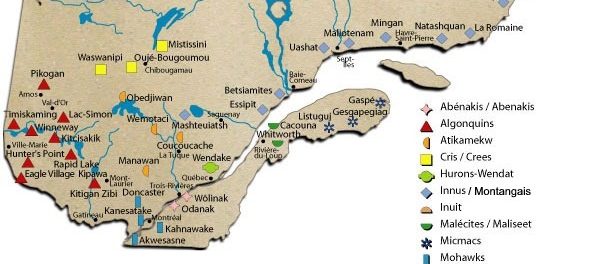Quebec’s Aboriginals, Part III & Other Quebec Curios
Wrapping up about the First Nations and Inuit that first came to Canada, we conclude this part of our discoveries of Quebec History. It is difficult to speak about a whole community without stereotyping and generalising, though we hope at Quebec Curios that our exploration over the past few weeks have helped cast an eye on the diversity of the first peoples that would inhabit Quebec.
Mohawk (Iroquois)
One of the few matrilineal societies of its time, the name for this community actually came from their Algonquin-speaking rivals, from a term meaning the Bear People. The French who arrived called them the Iroquois, another Algonquian term for the Five Nations, a confederacy of five Amerindian tribes who banded together for protection. Iroquois is also the name for the language these people spoke, as opposed to the Algonquian language. European contact is estimated to have wiped out about 60% of the Mohawk population due to the spread of new diseases such as smallpox. However, the Mohawk today are the most populous of the aboriginal nations living in Quebec, with three communities: the Akwesasne, the Kahnawake, and the Kanesatake. Population today: about 17 346.
Mi’kmaq (Algonquin)
The Mi’kmaq were semi-nomadic, meaning that they would move from small communities in the summer to smaller hunting bands in the winter. Until the creation of the federal law, the Indian Act, the Mi’kmaq governing system was the Grand Council. The Grand Council would gather the leaders from each of the seven main districts that the Mi’kmaq were known to settle in and take decisions. The Mi’kmaq have three communities living in Quebec: the Gespeg, the Gesgapeglag, and the Listuguj. Population today: about 5259.
Naskapis (Algonquin)
The name for this community comes from a term meaning “people beyond the horizon”. The Naskapis are a subgroup of the Innu, a separate but linked community to the Montagnais Innu tribe covered last week. Where the Naskapis are nomadic and live further up north in Quebec, the Montagnais Innu are sedentary and greater in number. The Naskapis have one community that live in Quebec, the Kawawachikamach. Population today: about 1130.
Wendat (Iroquois)
The Wendat were named the Huron people by the French due to the hair style of the men in the community. Part of the Iroquois confederacy, this matrilineal nation settled mostly in villages, moving every so often once the surrounding area once farming soils were depleted. The Wendat are estimated to have suffered a loss of over 10 000 people due to European contact, mainly through diseases such as smallpox and measles. The Wendat have one community in Quebec, the Wendake. Population today: about 3040.






